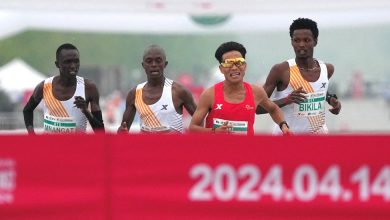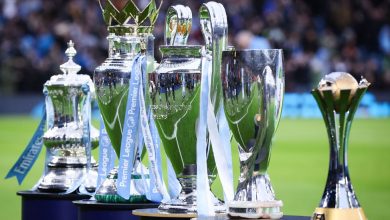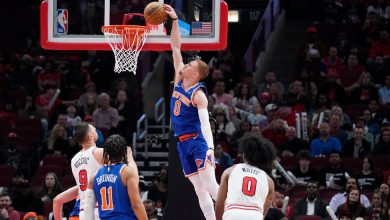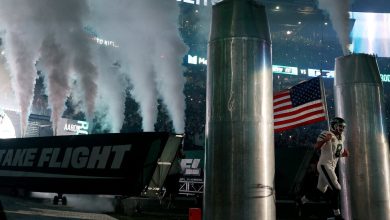Nadal and Djokovic Meet Again, With Gen Z Breakout in Wings

PARIS — The rivalry between Rafael Nadal and Novak Djokovic began in the quarterfinals of the French Open.
Sixteen years later, it just might end in the quarterfinals of the French Open.
“We have to be ready that this could be the last time they play in a Grand Slam,” said Mats Wilander, 57, a three-time French Open men’s singles champion. “I think we have to cherish this moment and not get ahead of ourselves.”
No one has prospered by underestimating either player’s resilience or powers of recuperation. But the future seems particularly uncertain in light of Nadal’s chronic foot condition that is now flaring up with alarming regularity and, by his own admission, sapping some of his trademark enthusiasm for the struggle.
Nadal vs. Djokovic has been, undoubtedly, one of the best and closest extended tussles in sports: with ebbs and flows in confidence and dominance in matches across four continents and, unlike with Nadal’s less prolific rivalry with Federer, at all four of the Grand Slam tournaments.
Nadal and Djokovic, both 35 until Nadal’s birthday on Thursday, once shared a closer connection and even a publicist, but whatever their disagreements now on Covid-19 vaccination or tennis politics, they will always be connected as part of the triangle that has defined men’s tennis since the late 2000s, when Djokovic rose to meet the bar set by Nadal and Federer.
But Tuesday’s quarterfinal, which will be played at night at Roland Garros despite Nadal’s lobbying for the day session, comes at an intriguing moment on multiple levels.
For the first time, a group of much younger players who look like a legitimate collective threat has emerged: a Generation Z cohort all 21 years old or younger. It is led with panache by Carlos Alcaraz of Spain and includes the Canadian Felix Auger-Aliassime, who pushed Nadal to five sets on Sunday, and Holger Rune, a potentially great Dane in a backward ball cap who knocked out Stefanos Tsitsipas, last year’s French Open runner-up, with a bewitching brew of power and touch on Monday on the main court, Philippe Chatrier.
Alcaraz and Rune are just 19 and in the quarterfinals, and though Nadal vs. Djokovic will take up plenty of air and head space between now and very late Tuesday night, there might be even more anticipation within the sport to see Nadal or Djokovic face Alcaraz in the next round than to watch Nadal and Djokovic play for a 59th time.
The novelty factor is real, particularly after Alcaraz beat Nadal and Djokovic back-to-back on red clay to win the Madrid Open earlier this month.
There are no shortage of dissenters, of course.
“I’ll take No. 59,” said Julien Benneteau, the French former player who is now the country’s King Cup captain. “These guys are two monuments of tennis, along with Federer. I can’t wait to watch it again.”
Alcaraz, full of flash and fire, is no lock to reach the semifinals, even if he will be favored against the No. 3 seed Alexander Zverev in a quarterfinal that will end the day session on the Chatrier Court before the main event occupies the red, rectangular stage.
Nadal, a creature of habit, as his precisely aligned water bottles make plain, was clear after beating Auger-Aliassime that he wanted a day match. Night sessions are a new development at the modern French Open, introduced last year albeit with reduced capacity because of pandemic-related restrictions.
Night sessions are a longtime staple of the U.S. Open and the Australian Open, the two Grand Slam tournaments played on hardcourts.
There are also night sessions at other European clay-court events, including the Madrid Open and the Italian Open, which Nadal has still managed to win 10 times. But his night match this year in Rome against Denis Shapovalov did not end happily as Nadal lost in three sets, limping noticeably and grimacing as he struggled to finish the final set, casting doubt on his preparations for Roland Garros.
Conditions can change considerably on clay after dark, particularly on a cool and relatively humid night when the balls get heavier and bounce lower: no boon to Nadal’s lively topspin forehand.
“The match with Djokovic could be my last match here,” Nadal said on Sunday, sounding somber. “I know Roland Garros during the day and prefer to play during the day. I’ve gone through a complicated situation with my foot, and I don’t know what’s going to happen with my career. What I’m trying to do is enjoy and continue living the dream to play tennis and get to the final rounds of Roland Garros.”
Despite that plea, the French Open organizers remained unconvinced or perhaps had contractual obligations to Amazon Prime Video, which holds the night-session rights in France.
No. 59 will be a night match, just as the remarkable semifinal between the two at last year’s French Open turned into one after starting in the late afternoon.
“Unfortunately, every year they play one round earlier here,” said Goran Ivanisevic, Djokovic’s coach. “Two years ago it was the final. Last year it was the semis and now the quarters, but it’s probably the best quarterfinal ever in the history of the French Open.”
Their two previous quarterfinal duels at Roland Garros were actually no great shakes. In the first in 2006, their first meeting at any level, Djokovic retired with an injury after losing the first two sets.
In 2015, Djokovic, in peak form with Nadal in an extended slump, became only the second man to defeat Nadal at Roland Garros, routing him 7-5, 6-3, 6-1 in what looked, incorrectly, like the end of an era for Nadal at the French Open. He has gone on to win it four more times.
But he did not win it last year as Djokovic became the first man to beat Nadal twice at the French Open, prevailing 3-6, 6-3, 7-6 (4), 6-2 in a match that’s intensity and shotmaking peaked in the third set before Nadal, struggling with his foot and Djokovic’s excellence, faded in the fourth.
“Their third set last year was probably the best set of tennis I’ve seen,” said Darren Cahill, the retired player, longtime ESPN analyst and leading coach.
They have not played since, but Djokovic comes into the quarterfinal with the momentum after reaching the final in Madrid — losing a tight match to Alcaraz — and then finding a higher gear to win the Italian Open without dropping a set.
“I think this year and 2015 are the two times when he is the clear favorite,” Nadal said of Djokovic. “The other times I was a bit more, or it was 50-50.”
After being forced to miss the Australian Open because of his anti-vaccination stance and being deported on the eve of the tournament, Djokovic had to watch from afar — and with jet lag — as Nadal passed him in the men’s record books by winning his 21st Grand Slam tournament singles title.
But after returning to the tour full time in April and struggling with his endurance and his timing, he has gathered serious steam. Enough to handle a grinding, grueling five-setter with Nadal on the Spaniard’s signature surface?
“Novak is ready for best-of-10,” Ivanisevic said. “It was not easy. Australia threw him back a little bit, but people like him, these genius people, have a different brain, and he needed a little bit of time.” He added: “So far he’s playing well, hitting the ball well, and he’s ready. Rafa is ready, so we see.”
Nadal, lacking depth and percussive power at times against Auger-Aliassime, managed to find his most convincing tennis in the closing games.
“Rafa is match toughened this year with having hit the wall many times and finding ways to win,” Cahill said. “Novak has only just started looking good and has coasted in Paris. He will feel his lungs popping out of his chest for maybe the first time this year.”
Djokovic leads their overall series 30-28, but Nadal still leads 10-7 in Grand Slam matches and 19-8 on clay. This will be their 10th match at Roland Garros: more than any men have played each other at any tour-level event in the Open era.
After facing off 58 times (and in a few more exhibition matches), there can be no secrets on court. Nadal knows that breaking down the elastic Djokovic from the baseline is one of the toughest asks in tennis. Djokovic knows that regaining control of a rally once Nadal has begun to dictate its terms with his whipping forehand is every bit as daunting.
“Watch for Rafa’s forehand down the line,” Cahill said. “He will try and stretch Novak to that side as his defense on the backhand is crazy good.”
They have never been the biggest servers and are no longer the biggest hitters, but they have grown into supremely complete players, increasingly prone to attacking or even serving and volleying when they need it most, irrespective of the surface.
Above all, they have grown, despite their differences, into two of the greatest and enduring champions in any sport, both poised to finish with the record for Grand Slam men’s singles titles that has become, however reductive, the tennis gold standard.
Win on Tuesday and Nadal can protect his slim lead. Lose and Djokovic will have a tying 21st in his sights, though not necessarily in his grasp. Tougher matches just might await.



